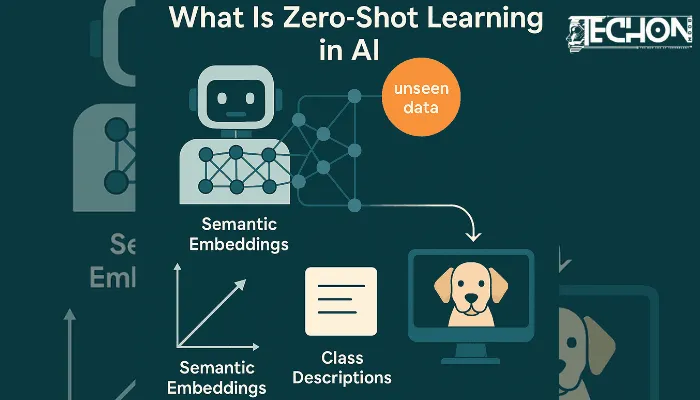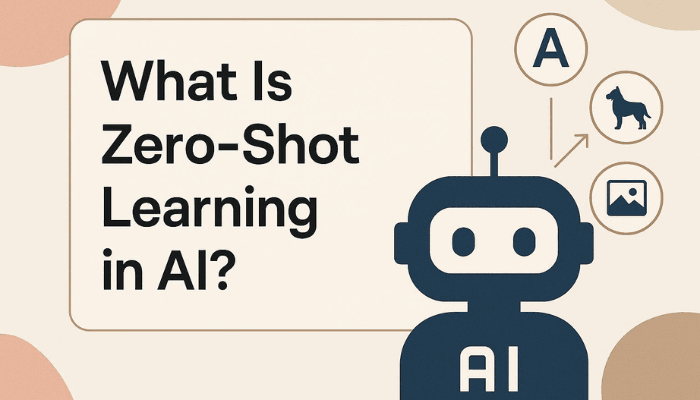AI has recently made incredible progress, which has made exciting new progress in our lives, but many AI models still require labeled data to make large amounts of labeled data effective. For example, if you want to build an AI model that can identify different dog breeds, you will usually need to feed thousands of labeled dog images for training. But imagine if the model can identify a brand-new dog breed without any pre-training on it!
This is the place where learning zero-shot comes into the game. In this article, we are going to dive into zero-shot learning, how it operates, why it matters, and how it makes practical use in the real world, thus facing obstacles.
What Is Zero-Shot Learning (ZSL)?
Zero-shot learning (ZSL) AI is a technique where a model can provide accurate predictions of new, unaffected data without being trained on it. In simple words, we can say that the zero-shot learning AI models allow the model to recognize or understand new things on the basis of knowledge that has already been learned from similar functions or related data. Example of learning zero-shot.
If the AI model is trained to identify cats and dogs, and you can show it a picture of a rock, the model can identify it properly based on shared properties such as fur, pointed ears, and shape – even if it has never seen the reef before. The main idea behind ZSL is that the model understands the relationship between known and unknown data based on general knowledge rather than direct training.
How Does Zero-Shot Learning Work?
Zero-shot learning relies on two main components:
1. Semantic Embeddings:
The Semantic embedding is how AI models understand the relationship between different concepts. Each object, word, or image is depicted as a mathematical vector (a point in a multicolored place). These vectors represent the underlying properties or properties of the object. The model teaches these vectors to map the properties of known objects(eg. shape, color, and size).
For example, A cat may contain a vector [0.8, 0.2, 0.1] (fur, size, and ear size representation). A dog may have a vector [0.7, 0.3, 0.2]. If a new item (like a fox) produces a vector [0.75, 0.25, 0.15], the model can conclude that it is similar to both cats and dogs. This allows the mapping model to normalize new categories without direct training.
2. Class Descriptions:
The ZSL models have gone beyond learning only from direct examples and now understand objects and categories through details. These details are often in the form of human-written text or they can be placed in embedding structures. To make a prediction, the model evaluates the characteristics of an unfamiliar object against known characteristics that are described. This technique helps the model group in different objects that have specific characteristics in general.
For example, A fox can be described as “a shrub tail and a four-foot mammal with pointed ears”. If the model knows the description of a cat and a dog, it can compare the description of Fox with known data and predict the nearest match.
Types of Zero-Shot Learning
Zero-shot learning can be divided into two main types based on how the model learns and processes information:
1. Inductive Zero-Shot Learning:
The model only learns from the seen data and the descriptions of the classes. No extra information about the unseen class is provided during training. The model relies entirely on existing knowledge to make predictions about the unseen class.
Use Case: An AI trained to identify domestic animals might identify a fox correctly based on its similarity to cats and dogs without ever having seen a fox before.
2. Transductive Zero-Shot Learning:
The model can see some examples of the new class without labels while it’s learning. It tweaks what it thinks by looking at these unlabeled examples next to classes it knows. This way helps the model get a better grasp and make fewer mistakes.
Use Case: If the model is shown an unlabelled image of a fox, it may compare the image with its knowledge of cats and dogs and classify the fox correctly.
Why Is Zero-Shot Learning Important?
Without a doubt, it constitutes zero-shot learning as a very crucial step in the direction of creating a much more flexible and human-like style of reasoning in AI. Because the conventional AI model is limited by what it has been trained on, it cannot adapt to new situations easily. ZSL simply rectifies this shortcoming by ensuring that the models are able to transfer knowledge generalizations.
1. Reduced Training Time and Cost:
Training extensive AI models incurs huge amounts of labeled data and massive computational power. ZSL minimizes this requirement as it allows a model to learn generalizations from existing knowledge instead of through training. Then, it will cut down the cost and time necessary to extend into newer AI models.
2. Improved Performance in Low-Data Situations:
In many real-world examples, it is difficult to collect large datasets(where rare diseases or rare languages are the examples). ZSL helps the AI models perform well when the training data is small or incomplete.
3. Better Adaptation to New Data:
AI models generally struggle when they face new categories or unforeseen data. ZSL allows them to adapt and predict the data even without retraining. This translates into a highly scalable approach and adaptability for AI in dynamic ecosystems.

Real-World Applications
Zero-shot learning is already being used in various industries:
1. Natural Language Processing (NLP):
The ZSL enables the AI model such as GPT-4 to generate reactions to neglect questions by taking advantage of semantic embedding and relevant patterns. This machine enhances translation systems, allowing them to explain and translate their languages or dialects, on which they are not trained. Chatbots and virtual assistants use ZSL to handle the user questions that distract from pre-educated reactions, user to improve experience and adaptability.
2. Image Recognition:
The AI-operated vision systems use ZSL to identify unfamiliar objects in images by portraying the similarity of known categories. Applications range from safety (identity of potential threats) to wildlife protection (classifying rare or newly discovered species). In e-commerce, visual search engines use ZSL to identify and recommend products, even if they are not clearly labeled in the system. Deep Learning for Zero-Shot Image Recognition
3. Healthcare:
Medical AI Systems used ZSL to help diagnose rare diseases by comparing symptoms and imaging data in known cases. In analyzing MRI and X-ray scans, radiologists identify the discrepancies in AIDS that are similar to the known medical conditions. The ZSL also contributes to drug discovery by predicting the effectiveness of new compounds based on the similarity of existing drugs.
4. Autonomous Vehicles:
Self-driving cars use ZSL to navigate unfamiliar road conditions, traffic signals, and obstacles by referring to pre-driving data. This helps vehicles handle unexpected conditions, such as new road layouts or construction areas, without the need for specific training for each landscape. AI-driven traffic management systems can optimize the routes and detect discrepancies in real time using ZSL.
5. Recommendation Systems:
Use ZSL to recommend materials based on streaming user behavior to platforms such as Netflix, YouTube, and Spotify, even when no direct matches exist. E-commerce sites take advantage of ZSL to suggest new products based on customer preferences, even when those items were never purchased before. Social media platforms use ZSL to suggest new connections, trending subjects, and personal advertisements.
Challenges of Zero-Shot Learning
While ZSL is powerful, it is not perfect. It comes with a few challenges:
1. Misclassification Risk:
Since ZSL depends on similarities between known and unknown objects, it can sometimes get it wrong. Let’s discuss with an example, it can be a mistake to analyze a wolf for a dog because they have similar features like fur,4 legs, and sharp teeth. This happens because the model does not have actual training data for the new categories just inferring from what it already knows.
2. Limited by Training Data Quality:
ZSL models Depend on descriptive information to understand new categories. If this information is inaccurate or biased, the model’s predictions will be too. In simple terms we can say that: Garbage in, garbage out. If the training data is bad, the model will struggle to make good decisions.
3. Scalability Issues:
As more unseen categories are added, the ZSL model gets more complex. Handling more and more unknown objects while maintaining high accuracy is a big challenge. The more diverse the dataset, the harder it is for the model to associate new concepts without getting confused.
Future of Zero-Shot Learning
Zero-shot learning is becoming more important because AI models handle large and more complex datasets. May be involved in future progress:
Better Concept Understanding: Future AI will get better at understanding and representing objects and ideas mathematically. They will be able to recognize patterns, similarities and differences more effectively even without seeing specific examples before.
Multimodal Zero-Shot Learning: Instead of just text or images, future ZSL will combine multiple types of data – text, images, sound – to make better predictions. For example, an AI could understand a new object not just from the description but also from related images and sounds to recognize unfamiliar concepts.
Continuous Learning: One of the biggest challenges in AI is that models need to be retrained with new data. Future ZSL will have continuous learning so models can refine their knowledge and get better over time without needing to be retrained constantly. This will make AI models more adaptive and efficient.
Cross-Domain Zero-Shot Learning: Traditionally AI models work well within a single domain – like recognizing animals in photos or translating languages. Future ZSL will enable models to transfer knowledge across different domains. For example, an AI that has learned to recognize objects in photos can apply the same concepts to medical scans or even satellite images without additional training.
Conclusion
Zero-shot gaining knowledge of changes in how AI fashions recognize and are expecting new records. By studying from info and semantic embeddings rather than direct training, AI fashions may be suitable for brand-spanking new situations, reducing training fees, and improving overall performance in the real world.
As AI continues to expand, ZSL will play an important role in making AI more bendy and adaptable in the ever-changing global.
Related Posts:-
Self-Learning AI: How AI Models Will Train Themselves Without Human Data

